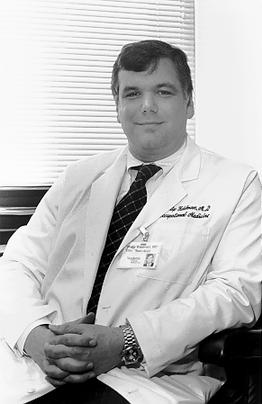
Dr. Philip Edelman
Edelman to craft international standards for safe workplace
A safe level of a toxic substance in a European workplace may not necessarily be considered a safe level in the United States.
Neighboring countries, separated only by a line on a map, can also have different air quality standards for the workplace.
Though it would make sense in today's rapidly expanding global economy for them to be the same, they are not ‹ a situation a Vanderbilt University Medical Center faculty member is working hard to change.
The chief of VUMC's division of Occupational and Environmental Medicine, Dr. Philip A. Edelman, is serving on a committee seeking to establish international recommendations for acceptable air and biological concentrations of hazardous substances such as benzene, lead and asbestos.
The goal is to promote worldwide standards to help prevent workplace injuries related to hazardous materials.
Edelman is vice chairman of the Biological Exposure Index committee of the American Conference of Governmental Industrial Hygienists, which met recently with their German counterparts to work on recommendations for acceptable chemical levels in the workplace. The volunteer group is made up of physicians, toxicologists and epidemiologists.
"The United States is preeminent in establishing these standards," Edelman said. "The other major country producing these standards is Germany."
The two groups met one month ago in Munich.
"The intent of our meeting was to look at harmonizing the standard interventions, not just the number, but the process as to how the standards are set," he said.
Edelman said it will be much less confusing and much less work for countries to share information about substances, since scientists around the world are reaching similar conclusions and are producing similar documents.
"We ought to write them jointly to save manpower," he said. "But first we have to come to a total agreement as to how we review the available scientific literature."
Edelman said it is especially important to have international agreement on the numbers as more and more companies become multi-national.
"There is less confusion when you don't have to worry that, five miles across a border, the numbers are different. That's part of the goal, to coordinate," he said. "The current differences, while understandable to scientists, is very confusing to workers, companies and governments. We want everyone to understand what we do and how standards are established."
Hazardous substance levels aren't the only things that need to be coordinated. There also needs to be agreement on the number of minutes or hours that it is safe to be exposed to a certain substance, an important factor in today's workplace environment of different work schedules. There is more research today pertaining to setting these important levels, Edelman said. Years ago, a number was established mainly by people sitting around a room and agreeing on a number.
"Today, it's a much more elaborate process. There is laboratory research and people are taking much more time and effort to come up with these levels."
Edelman said it is natural for the United States and Germany to begin working on the process since the two countries are the two largest promulgators of the standards.
"If we could get together and agree, we would like other countries to join this process. The German commission and our group can make some headway. This is a first step."
Edelman is vice president of the Tennessee College of Occupational and Environmental Medicine and is a member of the board of directors of the American Academy of Clinical Toxicology.
He said his work on the international committee is part of his involvement at VUMC in developing a program in occupational medicine ‹ the provision and management of health care for work-related health problems.
"Today we've included the total health and management of the patient beyond the work environment. Vanderbilt is looking at ways to provide occupational health and environmental health services to the community in keeping with the Vanderbilt mission, especially in one specific area: toxicology in the workplace," he said.
Edelman said Vanderbilt's reputation in clinical pharmacology and molecular toxicology is one reason why the medical center is an ideal location for a division of occupational and environmental medicine.
"We have the resources to be applied to this area," he said. "One goal is to link basic sciences to a real, every day setting, but we need people to go into the workplace to measure air contaminant levels and validate tests on exposures.
"This is a fairly unique concept. There is no place in this region with a department quite like this," he said.
Five to six patients are seen in the division each week with chemical-related occupational health problems ‹ injuries to the skin, liver and lungs.
"We aren't just diagnosing and treating these problems. Our focus is on prevention. When we see a person with a work-related injury, the system has failed. We don't just want to make this person better, but to enable the patient to return to work and to his or her life. If one person is injured, then there are more people in that setting who could be injured."













